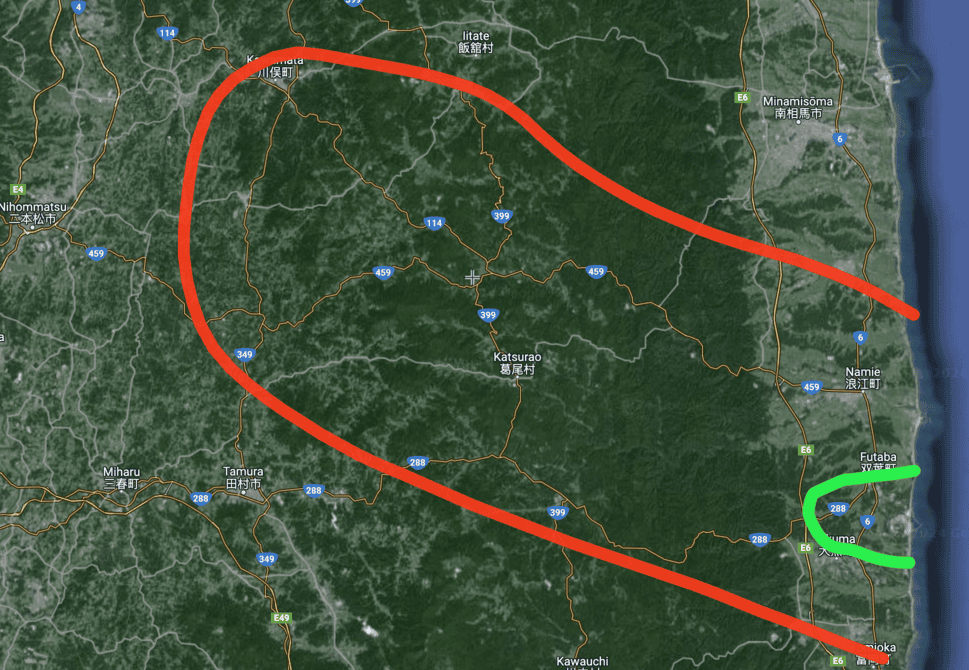Trying to understand the impact of Fukushima Daiichi nuclear accident
In [[books/J. Storrs Hall - Where Is My Flying Car]], the author (Josh) discusses at length the overblown risks of nuclear energy.
The argument could be summed up as “ionising radiation is much less dangerous than the mainstream opinion”.
I do believe that [[Scary ideas live longer]], and so it would be in line with my mental model if the public gets scared into making policies/decision based on fear, rather than real data.
This short post will sum up my research on the topic. I’m not an expert. I’ll add all my references so you can make your own conclusion.
Surprising claim 1: Nobody died from radiation exposure - True
-
The 2011 Tōhoku earthquake and tsunami killed roughly 20,000 people.
-
Residents weren’t exposed to harmful radiation
-
No harmful health effects were found in 195,345 residents living in the vicinity of the plant who were screened by the end of May 2011. All the 1,080 children tested for thyroid gland exposure showed results within safe limits, according to the report submitted to IAEA in June. … So while the was no major public exposure, let alone deaths from radiation, there were a number of victims of ‘disaster-related death’, especially old people uprooted from homes and hospital because of forced evacuation and other nuclear-related measures.
-
No adverse health effects among Fukushima residents have been documented that could be directly attributed to radiation exposure from the accident.
-
-
Emergency workers (20000) of them received on average 13mSv extra radiation (174 of which received dose higher than 100mSv) (UNESCAR 2020 report)
- 13mSv is 2 to 3 years worth of background radiation or 2 chest CT Scans
- 100mSv is twice the yearly limit for radiation workers in US
-
The conclusion is that nobody got injured by ionising radiation and 174 people might have slightly elevated ERR (excess relative risk) of cancer.
- Slightly because it is roughly 8% per 100mSv according to J-EPISODE Japanese study however, the confidence intervals also included 0%
- For those 174 people it means that if someone’s chance of getting cancer was 10%, after the work on Daiichi rescue operations, their chance is 10.8%
- Slightly because it is roughly 8% per 100mSv according to J-EPISODE Japanese study however, the confidence intervals also included 0%
-
174 people having 8%+ higher relative cancer seems like a rounding error to 20k people dead, 6k injured, and 2k missing.
Surprising claim 2: there is no-risk threshold for low-dose radiation - Maybe, but I wouldn’t bet my health on it
- Hermann J. Muller discovered in 1926 discovered that ionising radiation causes genetic mutations. He got Nobel Prize for it.
- During his Nobel Prize lecture, he argued that there’s no limit bellow which the ionising radiation would not be harmful. This is know as the LNT Linear No-Threshold Model.
- Whether this model is true or not is disputed
- Josh (the author of the book) is proponent of a threshold. I had a look at several research papers on the topic
- Direct Risk Comparison between Radiation and Smoking on Cancer Mortality among Nuclear Workers in Japan
- Maybe 100mSv could have 0.08 ERR, but the statistical significance is not high enough
- The International Nuclear Workers Study - INWORKS
-
The evidence did not suggest any large ‘no risk’ threshold for dose, or any possible beneficial effects
- 0.47 ERR for 1 Gy (Sv) and they suggest that the effects are linear, so 4.7% per every 100mSv extra
-
- Direct Risk Comparison between Radiation and Smoking on Cancer Mortality among Nuclear Workers in Japan
- So whilst it seems that the effect of low exposure are tiny, there might be some. I wouldn’t want to live in a place where I get more than 10 mSv a year (average American gets 6mSv)
Suprising claim 3: 1600 people died prematurely thanks to mandatory evacuation of the exclusion zone
- This is a contested claim. If it was true, it would mainly concern very old people who were uprooted from their homes.
- Source: NBC News id:: 65db2fb2-581d-47f9-a8da-e3fb436b86c9
- However, if you want to sink your time into some drama, read the Wiki discussion about this contest
- I think it’s plausible but I wouldn’t treat it as hard truth unless another source is provided.
Suprising claim 4: Evacuation and establishment of exclusion zone is a huge overreaction
- The “Claim 1” discussion above states that no resident was harmed by excess radiation. That might not be true if the Japanese government didn’t go beserk with the evacuation. So this is not black and white. We couldn’t have no evacuation and no irradiated people at the same time.
- That being said, following is a discussion of the current (early 2024) state of affairs.
- Looking at the radiation measurement map. Except for the few kilometres around directly next to the powerplant, there is very little radiation.
- Based on the research above, I’d be OK with receiving extra 5mSv a year (added to the 4mSv of background radiation), that leads up to 0.57micro Sv/h
- The exclusion zone is huge https://fukushima.travel/page/safety#map
- It could be smaller. This is my rough drawing (red is existing exclusion zone, green is where the radiation seems potentially dangerous).
Key takaways
- When put in comparison with the Tsunami (or even a bad month in traffic accidents) the human harm is neglegable
- Whilst I think that the exclusion zone is orders of magnitude larger than it should be, I understand the fear. When someone says every radiation is bad radiation, you want to be as far from Daiichi as possible. We could really use some research into what does 100mSv a year for many years mean. If it’s no big deal, we are spending so much money and effort for nothing.
